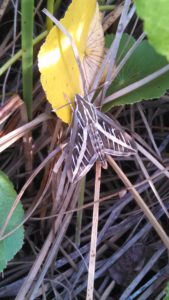In my last post I mentioned that two of the biggest challenges facing native moth populations are unintended targeting by biological control species and habitat fragmentation. With regard to biological control, the remedy is to be as selective with insect-specific controls as we are with other species, and that’s something to be addressed at a policy-level. The issue of habitat conversion and fragmentation can be addressed at a much smaller level, sometimes even in your own backyard. There’s a lot of recent research looking at the habitat elements that make a place good for moths, and we can use that information to create management strategies that help us utilize the resources we need while also giving moths a place in the equation.

I found this moth while doing field work about 100 m from the Gulf of Mexico- not exactly who I thought would be hanging out in the marsh grass!
It’s about structure, structure, structure. And by that I mean both the community of plant species in a location and the way that those plants fill the vertical space. Moth research from Finland suggested that the quality of habitat for larvae was more important for species persistence in a location than the ability of adult moths to actually get to the location (Várkonyi et al. 2003). For many species of moth, that means having the right plants available at the right time. Researchers monitoring moth communities in southern Bohemia believed that the reason moth diversity had remained pretty stable over 25 years was that the local plant community provided a number of specific, diverse microhabitats (Spitzer and Jaroš 2009). A changing climate may create issues there, since some moth species seem to be reproducing later in the summer even as plants are shifting to an earlier schedule (Liu et al. 2011). And for other species in managed forests, the harvesting program can be important– sometimes selective logging removes specific plant species from the landscape, leaving specialist moths high and dry (Summerville and Crist 2002). As it turns out, logging is about more than just removing trees when it comes to moths- trees sometimes change leaf chemistry in response to disturbance and a researcher in Indiana found that trees as far away as 200m from logged sites were impacted (Summerville 2011). Changing leaf chemistry can mean lower quality food for moths. Fortunately, there are things we can do to give moths both the types and shapes of the plants they need– Summerville (2013) found that removing ~15% of the timber helped butterfly and moth communities recover faster when compared to group and clear-cut logging. And researchers in Finland recommended having cattle graze some unused pastures to help maintain a mix of species and plant sizes (Poyry et al. 2005).
And connecting the dots is a good thing, too. Research in the UK found that moths which specialize in forest habitats moved smaller distances in general (Slade et al. 2013)- as forest fragments get farther and farther apart, these moths will be less likely to move between locations, which means that, if a population disappears in one spot, it is less likely to reestablish later. As Ricketts et al. (2002) commented, landscape mosaics are important because they provide a variety of habitats, and, if the patches if similar habitat aren’t too far away, moths can move more easily between them. Hedgerows and additional tall vegetation around single trees can help provide corridors and stepping stones for moths to disperse along. Corridors are also helpful in other types of habitats- an assessment of agri-environment strategies in the UK found that moth populations in agricultural landscapes were particularly helped by leaving strips of natural or semi-natural vegetation along waterways and field margins (Fuentes-Montemayor et al. 2011).
All of this research really connects back to the fact that moth species use a variety of habitats and differing combinations of plants within those habitats, so protecting moth populations means protecting a variety of plant species and a means to get between those plants. What can we do to support them, even if we don’t have a backyard moths can use as habitat? In my final post of the moth, I’ll look into ways for everyone to get involved in moth conservation.
Works cited:
Fuentes-Montemayor, E., D. Goulson, and K.J. Park. 2011. The effectiveness of agri-environment schemes for the conservation of farmland moths: assessing the importance of a landscape-scale management approach. Journal of Applied Ecology 48:532–542.
Liu, Y., P.B. Reich, G. Li, and S. Sun. 2011. Shifting phenology and abundance under experimental warming alters trophic relationships and plant reproductive capacity. Ecology 92:1201–1207.
Poyry, J., S. Lindgren, J. Salminen, and M. Kuussaari. 2005. Responses of butterfly and moth species to restored grazing in semi-natural grasslands. Biological Conservation 122:465–478.
Ricketts, T.H., G.C. Daily, and P.R. Ehrlich. 2002. Does butterfly diversity predict moth diversity? Testing a popular indicator taxon at local scales. Biological Conservation 103:361–370.
Slade, E.M., T. Merckx, T. Riutta, D.P. Bebber, D. Redhead, P. Riordan, and D.W. Macdonald. 2013. Life-history traits and landscape characteristics predict macro-moth responses to forest fragmentation. Ecology 94:1519–1530.
Spitzer, K., and J. Jaroš. 2009. Long-term monitoring of moth populations (Lepidoptera) associated with a natural wetland forest: synthesis after 25 years. Terrestrial Arthropod Reviews 1:155–163.
Summerville, K.S. 2011. Managing the forest for more than the trees: effects of experimental timber harvest on forest Lepidoptera. Ecological Applications 21:806–816.
Summerville, K.S. 2013. Forest lepidopteran communities are more resilient to shelterwood harvests compared to more intensive logging regimes. Ecological Applications 23:1101–1112.
Summerville, K.S., and T.O. Crist. 2002. Effects of Timber Harvest on Forest Lepidoptera: Community, Guild, and Species Responses. Ecological Applications 12:820–835.
Várkonyi, G., M. Kuussaari, and H. Lappalainen. 2003. Use of Forest Corridors by Boreal Xestia Moths. Oecologia 137:466–474.
